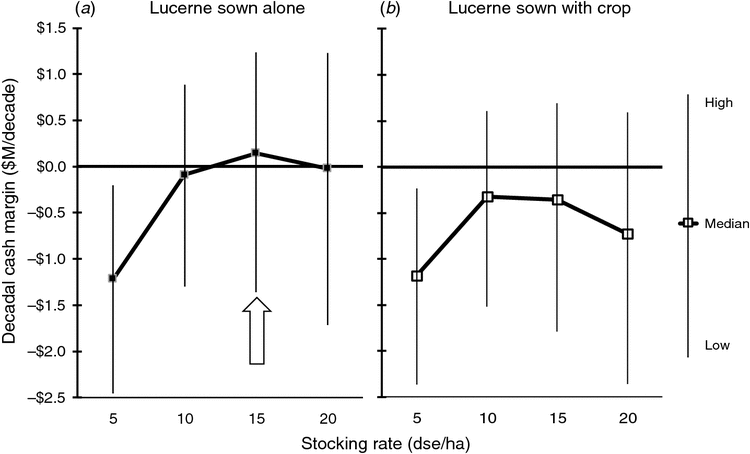Does establishing lucerne under a cover crop increase farm financial risk?
T. L. Nordblom A D , T. R. Hutchings A , R. C. Hayes A B , G. D. Li A B and J. D. Finlayson CA Graham Centre for Agricultural Innovation (an alliance between Charles Sturt University and NSW Department of Primary Industries), Albert Pugsley Place, Wagga Wagga, NSW 2650, Australia.
B NSW Department of Primary Industries, Wagga Wagga Agricultural Institute, Pine Gully Road, Wagga Wagga, NSW 2650, Australia.
C John Finlayson Research Limited, Whangarei, New Zealand.
D Corresponding author. Email: tnordblom@csu.edu.au
Crop and Pasture Science 68(12) 1149-1157 https://doi.org/10.1071/CP16379
Submitted: 14 October 2016 Accepted: 15 October 2017 Published: 29 November 2017
Journal compilation © CSIRO 2017 Open Access CC BY-NC-ND
Abstract
Rainfed farms in south-eastern Australia often combine annual cropping and perennial pasture phases with grazing sheep enterprises. Such diversity serves in managing diseases, pests and plant nutrition while stabilising income in the face of wide, uncorrelated variations in international commodity prices and local weather over time. We use an actuarial accounting approach to capture the above contexts to render financial risk profiles in the form of distributions of decadal cash balances for a representative 1000-ha farm at Coolamon (34°50ʹS, 147°12ʹE) in New South Wales, Australia. For the soil and weather conditions at this location we pose the question of which approach is better when establishing the perennial pasture lucerne (Medicago sativa L.): sowing with the final crop of the cropping phase, or sowing alone following the final crop? It is less expensive to sow lucerne with the final crop, which can provide useful income from the sale of grain, but this practice can reduce pasture quantity and quality in poorer years. Although many years of field research have confirmed that sowing lucerne alone is the most reliable way to establish a pasture in this area, and years of extension messages to this effect have gone out to farmers, they often persist in sowing lucerne with their final cereal crops. For this region, counting all costs, we show that sowing lucerne alone can reduce farm financial risk (i.e. probability of negative decadal cash balances) at stocking rates >10 dry sheep equivalents (DSE)/ha, compared with the practice of sowing lucerne with a cover crop. Establishing lucerne alone allows the farmer the option to profitably run higher stocking rates for higher median decadal cash margins without additional financial risk. At low stocking rates (i.e. 5 DSE/ha), there appears to be no financial advantage of either establishment approach. We consider the level of equity, background farm debt and overhead costs to demonstrate how these also affect risk-profile positions of the two sowing options. For a farm that is deeply in debt, we cannot suggest either approach to establishing lucerne will lead to substantially better financial outcomes.
Additional keywords: alfalfa, dryland cropping, economics, farming systems, pasture simulation, risk management, sowing time.
Introduction
A perplexing question for scientists and farm advisors over the last 80 years when dealing with rainfed crop–pasture rotations has been whether to recommend sowing a perennial pasture alone or with a cereal cover crop (Moodie 1936; Smith and Argyle 1964; Cregan 1985; Dear 1989). We consider the financial risks in the performance of rained lucerne (Medicago sativa L.) pastures sown with or without a cover crop over a 4-year perennial pasture phase followed by a 5-year cropping phase, as commonly found in south-eastern New South Wales (NSW), Australia. Comparisons of these pasture establishment methods have been the subject of several more recent studies (McCormick et al. 2012a, 2012b, 2014; Li et al. 2014; Swan et al. 2014). McCormick et al. (2014) highlighted the scant attention so far given to whole-farm business considerations around this question, observing: ‘… despite relatively consistent messages about reduced pasture performance due to competition from the cover-crop, farmers in the mixed-farming zone of south-eastern Australia continue to rely on the practice’.
In this region, rainfed farming is a gambler’s game (Malcolm et al. 2005). To use our example, the jackpot in establishing a lucerne pasture by sowing with a cover crop occurs when weather conditions result in both a well-established, persistent pasture and a high-yielding crop. Combined with the notion that this is the lowest cost way to establish a pasture, such an event is unforgettable. In the case at hand, as with so many other questions in agriculture, we must find ways to cope with risks (Lien et al. 2011; Hardaker et al. 2015).
Scott et al. (2000) studied pasture persistence given the effects of grazing by several livestock classes (i.e. wethers, breeding ewes, steers), comparing cash-flow changes over 15 years with separate enterprise budgets for native as well as sown and resown phalaris (Phalaris aquatica) pasture. They found that the most profitable pastures are those able to sustain increased stocking rates without the need for resowing. Several studies focused on the effects of changes in mixed farming systems in New South Wales (NSW) or Victoria (Behrendt et al. 2006, 2013; Armstrong et al. 2010; Scott et al. 2013; Trapnell and Malcolm 2014; Sinnett et al. 2017). Those studies employed stochastic price and weather variations as key sources of risk while optimising net present values (NPVs) of future streams of returns minus costs, subject to constraints such as pasture persistence or minimising variations in profits defined in various ways. Sinnett et al. (2017) stated the need to consider financial outcomes and limitations when estimating the likelihood of business viability in terms of farm equity and the risks attending indebtedness; they concluded that ‘focusing on technical or economic efficiency alone is insufficient because financing the change matters too’.
This paper aims to quantify the question of which is the better option in this region by comparing the farm financial risks associated with establishing pastures with or without a cover crop, based on prior research findings and use of new analysis from a series of field experiments during 2008–12 across a 170-km north–south transect in south-eastern NSW. Our simulation model uses results from these experiments to estimate variations in pasture dry matter production in the first grazing years for the two establishment methods given local rainfall records from 1950 to 2010.
Methods
Study area
Reported in detail by Swan et al. (2014) and Li et al. (2014), the study area covers the mixed farming zone of south-eastern NSW, where a series of field experiments was conducted in 2008–12. Monthly rainfall data were obtained from the Australian Bureau of Meteorology for the various locations, spanning the experimental period for the respective field experiments. The annual rainfall at these locations was well below long-term averages in 2008 and 2009, and 200 mm above average in 2010.
Our simulation model uses regression results from these experiments to estimate variations in pasture dry matter production in the first grazing year for the two establishment methods based on local rainfall records from 1950 to 2010 at Coolamon (34°50ʹS, 147°12ʹE) in NSW. On occasions when lucerne pasture sown with a crop fails to establish in any year (when growing season rainfall is <250 mm), we assume it reverts to annual pasture. Pasture production in years following the first grazing year was simulated with the GrassGro model (Donnelly et al. 2002) to allow calculation of the monthly net pasture energy production for the 60-year period for the chosen pasture type, using a routine developed for this model (Hutchings 2013, p. 70).
Variations in crop yields (canola, wheat, lupin, barley) were simulated with the same rainfall data for Coolamon conditions by using the French and Schultz (1984) method modified by Oliver et al. (2009). Thus, pasture and crop production varied roughly together year-by-year, because all are affected by the same rainfall conditions. Sheep enterprises cannot be selected simply on the basis of earnings per head or per breeding ewe because each enterprise requires differing amounts of feed. A standard measure of feed requirement is a dry sheep equivalent (DSE) (McDonald and Orchard 2017). With our sheep-stocking rates set at four levels (5, 10, 15 and 20 DSE/ha) supplemental feed quantities were calculated as the differences between available pasture production and known dietary requirements for sheep of different maturity classes in self-replacing flocks marketing fat lambs. Each DSE is assumed to require 2500 MJ/year (Hutchings 2013, p. 70). Feed calculations were done within the simulation model for each year of each decadal (10-year) iteration.
Although the same calendar year may be the first year of grazing for two lucerne fields, the one sown along with a crop was sown a year earlier than the pasture sown alone, and often under different weather conditions. We included this consideration in our regression model on pasture dry matter yields in the first year of grazing. Observability of advantages by visual comparisons of pasture productivity of these two sowing options, even in adjacent fields, is always confounded (Llewellyn et al. 2014).
Farming system
Our analysis assumes a typical mixed (crop–livestock) system on a 1000-ha farm in the Coolamon region of NSW, as described in Hutchings et al. (2014). We assume that the farm is divided into nine 100-ha fields managed in a rotation of 5 years of cropping followed by 4 years of pasture, as typical in the area. The remaining 100 ha allows for farm roads, yards, buildings, houses, fencing and uses other than grazing and cropping. All nine crop and pasture elements of the rotation are assumed present on fields of equal size (100 ha) on the farm each year, moving in turn to the next field each year according to the specified sequence. That is, each element of this 9-year rotation is present in one of the farm’s fields each year (Fig. 1). All fields, therefore, are subject to the same weather variations through time. A 10-year budget was optioned because it was sufficient to measure the long-term weather variability, and therefore production and financial risk, for each management option in each iteration. For instance, it allows for sampling among 50 decades of weather sequences in the 60-year historic series of variability in growing season and summer rainfall, and therefore pasture establishment success and yields. For each sowing method–stocking rate treatment, the sampling of weather decades was randomly combined with price variations. To maintain our basis for comparisons, we assume that the cropping–grazing sequences remain the same over time.
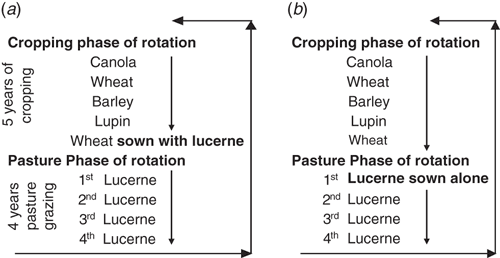
|
In practice, of course, farmers are free to choose and change their rotation sequences and stocking rates as it suits them; diversity is common in the mixed farming systems of the study area (Swan et al. 2014). Over the long term, with changes in costs and prices, and technical advances, or emergence of new problems such as pests, these patterns can be expected to change. Rodriguez et al. (2011) showed how plasticity (adaptability) is a desirable characteristic in farming systems operating in highly variable environments. At seven of nine locations across southern Australia, Moore (2014) found that the most profitable farming systems included some perennial pasture, but that no single species or land-use system predominates.
Farm business analysis principles
Instead of farm-management economics, the present paper uses financial business analysis methods, where the appropriate key principles are: (i) financial analysis, (ii) finance (cash-flow), and (iii) wealth (net worth). These business principles are those used by farm-management advisors, and accepted as normal and appropriate by the industry, its banks and other businesses. In this form of analysis, profit is an artificial construct accounting for only ~70–80% of total expenditure, and therefore does not reflect long-term changes in the cash balance, or wealth, of a business. The costs omitted in profit are living costs (plus tax) and capital replacement. If these two costs cannot be met, the farm will fail at some time in the future.
Living costs must be included because most farms are owner-operated businesses, which function to provide a stable and sufficient standard of living to the owners; without this (we assume $80 000, plus inflation) it would be difficult to raise and educate a family. Given a variable income, these living costs must be funded, in many years by debt, and therefore contribute to (or reduce) levels of net worth.
Depreciation costs, as used in tax accounting, can underestimate capital replacement costs significantly. This discrepancy arises because depreciation charges decrease with time, whereas the cost of new machinery increases; replacement costs capture the difference. The Intensive Farming (IF) model (Hutchings et al. 2016), which is used here, aims to simulate the actual dollar value of the cash balance in the future (rather than collapsing all results back to an NPV), so that the farmer can identify whether the debt at that time can be financed with the remaining equity, given the prudential lending requirements of the banks. This figure contains all of the variability, and all costs associated with the activity being modelled. The IF model calculates the real replacement costs for each item of machinery, considering age and expected lifetime, and enters this in the corresponding year in the cash-flow.
Cash-flow is used as the benchmark because it is the variable component of net worth:

The decadal cash margin is the change in the cash balance (or bank account) over the 10-year budget period, and is given by the equation:

where cash balances include the cash value of machinery and livestock replacement, and all costs are inflated over time. Farmers have little or no control over changes in farm asset prices, so that basing an analysis on cash-flow concentrates the output on the variable component of net worth affected by management decisions.
Opportunity costs (of other investment alternatives) can also be modelled in the same way and compared. An example is given in this paper, in which the opportunities given by sowing alone are compared directly with undersowing across a range of stocking rates.
The importance of going beyond typical NPV calculations in farmers’ decision making has been highlighted in previous studies (Hutchings 2013; Hutchings et al. 2014, 2016; Nordblom et al. 2015; Sinnett et al. 2017). Here we present 2000-iteration decadal Monte Carlo simulation results as a cumulative distribution function (CDF) for each establishment method at each of four stocking rates, beginning with a representative 80% opening equity for a 1000-ha typical crop, pasture and sheep farm at Coolamon, NSW. In terms of our use of such an actuarial business accounting approach that considers all costs in simulations deriving multiple estimates of decadal whole-farm cash margins across variable weather and price scenarios, the present paper represents perhaps the first attempt to assess the farm financial outcomes associated with the two approaches to lucerne pasture establishment.
Field experiments
Three small-scale field experiments and six large-scale, on-farm participatory experiments were sown along a 170-km north–south transect from Ariah Park (34°19ʹS, 147°13ʹE) and Yerong Creek (35°23ʹS, 147°04ʹE) to Brocklesby (35°48ʹS, 146°41ʹE), NSW (Li et al. 2014; Swan et al. 2014). Crop and pasture performance were monitored over 3 years after sowing. This included dry matter (DM) measurements for green aboveground biomass in what would be the first year of grazing and in the following years when possible.
Measurements of aboveground biomass observed in field experiments of pastures in the first grazing year, sown alone or with a cover crop, provide the basis for simulation of establishment success year-by-year and energy production in the first grazing year. In addition, pasture yields in the second, third and fourth grazing years were calculated with GrassGro to simulate total pasture energy production on the farm each year, using rainfall data sampled from the corresponding years in the 1950–2010 series. This permitted building upon the experimental results by using multiple decades of weather and price data for simulations capturing the wider range of financial results.
Results and discussion
Dry matter regression analysis
The field experiments yielded 42 sets of observations at the treatment/location/sample level across the geographic range of the transect with complete sets of data needed to calculate the first grazing year DM production, using Eqn 3:

where DM is total available aboveground biomass (kg/ha) in the first grazing year, i.e. the calendar year following the final crop when undersown lucerne is in its second year of growth, and when sown alone, lucerne is grazed later in the sowing year; GSR is growing season rainfall for the establishment year (P < 0.001); SRf2 is January–March rainfall in summer following establishment (P < 0.001); Na+ is concentration of exchangeable sodium in the top 0–10 cm soil, µg/g (P < 0.001); pH is soil pH (CaCl2, top 0–10 cm) (P < 0.1); Day is sowing date expressed as number of days after 1 May (P < 0.1); Usow is lucerne sown with a cover crop (P < 0.001); Dir is lucerne sown alone.
A pasture’s DM yields for the first grazing year are calculated by using the regression model shown in Eqn 3. DM in this case includes lucerne and any other vegetation such as weeds and annual legumes (e.g. subterranean clover, Trifolium subterraneum L.) that may be sown with the lucerne.
Pasture production in the subsequent 3 years is calculated based on success or failure of lucerne establishment and the weather conditions in each of those 3 years. In addition to the response model in Eqn 3, we have included two rules-of-thumb regarding pasture establishment and yields in the first grazing year, based on interviews with local farmers in the Coolamon area:
-
Lucerne establishment will fail if sown with a cover crop when GSR is <250 mm.
-
Lucerne sown alone will not fail to establish except in years of extreme drought, specifically 1967, 1976, 1983, 1994, 2003 and 2006 out of the 60-year sequence.
Our model assumes failure of lucerne to establish, in either case, will result in reversion to annual pasture in that field in the first year of grazing and for the following 3 years.
Whether lucerne is established or not, a pasture’s metabolisable energy (ME) yield for that farm’s final 3 pasture seasons is simulated with GrassGro, as lucerne or annual pasture, respectively. The DM regression parameters (Eqn 3) were then set for conditions found at Coolamon, including the rainfall data for that location (available from the Bureau of Meteorology). Pasture total DM yield in the first grazing year was simulated with the regression model shown above to capture the effects of rainfall, sowing date and soil characteristics from the field experiment (Fig. 2). Although only 42 observations had complete data, the ‘predicted’ values were highly positively correlated with the actual measures, enabling us to fill a gap left by GrassGro, which does not directly estimate lucerne yields in the first year of grazing.
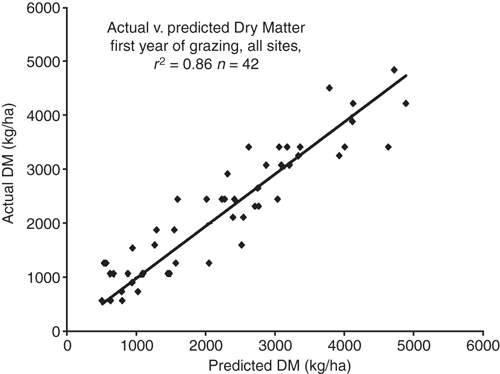
|
We converted the DM estimated from Eqn 3 to ME (MJ/ha) for each of the 60 seasons from 1950 to 2010, using GrassGro and a routine developed for this model (Hutchings 2013, p. 70).
This allows a new basis for a comparison of the two sowing methods because our simulated Coolamon farm will have four pasture fields each year, all either sown with a cover crop or sown alone and grazed in the calendar year following the final crop in the rotation. Given the 1950–2010 weather sequence for Coolamon, we calculated annual ME yield in each season across the four pasture fields on the farm by summing the total ME yield for all pasture fields on the farm for each year. This produced a measure of pasture energy in MJ/ha for the whole farm (four fields in pasture at different maturities) each year (Fig. 3). The results indicate that pastures of lucerne sown alone yielded higher ME than those sown under a cover crop in 40 of 60 years. Each point in Fig. 3 represents the mean total energy per hectare in that calendar year from grazing the farm’s four pasture fields.
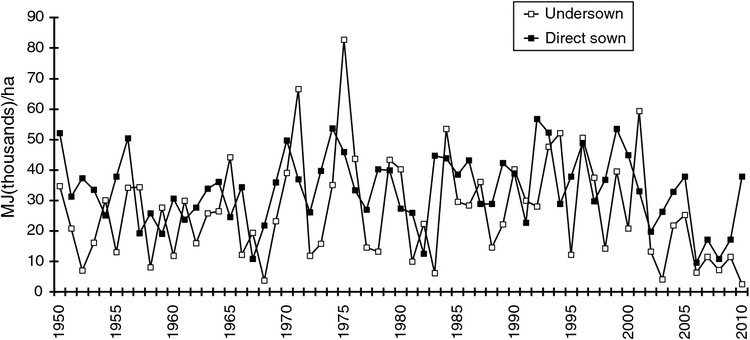
|
Economic analysis
The cost of sowing lucerne alone is $204/ha, whereas as the final crop in the rotation it adds only $55/ha to the costs of cover crop seed. Because the crop establishment costs are already committed, simply adding the lucerne seed at sowing may appear to be the ‘lowest cost’ way to establish a pasture. Our simulation accounts for lucerne establishment failure in a particular field in a particular year by assuming that the pasture will revert to annual vegetation for the remainder of its pasture phase. Supplementary feeding costs are minimal at low stocking rates because the pasture produces sufficient energy. By contrast, at higher stocking rates (10–20 DSE/ha), supplementary feeding will be required in most years, with far greater amounts in poor years (Fig. 4).
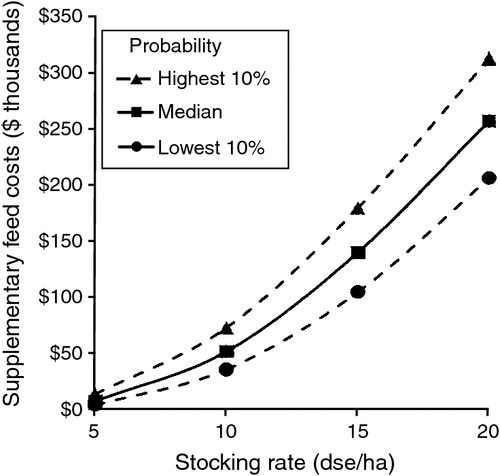
|
Four fixed stocking rates were used (5, 10, 15, 20 DSE/ha), and differences in financial risk profiles for these were calculated for both lucerne-establishment methods. Stocking rates for breeding flocks are manipulated by changing the ewe numbers and running a livestock reconciliation statement until the numbers stabilise, usually after 5 years. The percentages of births, sales and deaths are then adjusted until the opening and closing balances are equal, and this is then regarded as a stable flock structure for this flock at that stocking rate. This stable livestock reconciliation statement is then converted to a monthly basis, and the target liveweights for each month determine the monthly growth rates, and therefore the monthly flock energy demand, where liveweights are set to match Lifetimewool recommendations (AWI 2011; Hutchings et al. 2016). This energy demand is matched with the ME supply modelled by GrassGro. The energy input required from supplementary feed is then given by the size of any energy deficit, assuming a 70% feed efficiency. This method is highly correlated with the same output, as calculated within GrassGro (r2 >0.85). Our model does not allow for transitions between stocking rates, but assumes that the flock runs at the stocking rate selected, adjusting supplemental feeding year-by-year to compensate for pasture deficits when they occur.
Risk analysis
The IF model includes weather and price risks and all costs, allowing the comparison of farm financial-risk profiles for different management decisions in terms of probability distributions of long-term (decadal) whole-farm cash margins. We can now illustrate an application of this approach to the conundrum of how best to establish a rainfed perennial lucerne pasture under the local conditions of our study area in south-eastern NSW.
For a given enterprise, subtracting its annual input, harvest and transport costs for a year from its annual gross income gives a measure of gross margin for that year. Given year-to-year variations in input and output prices and growing conditions, gross margins will fluctuate over time. In most published analyses, average yields, average prices and average costs are assumed for calculations of gross margin for the average year, with the common implication that this represents the economic situation of a farm. Too often, this is the method used by decision makers and advisors to evaluate management changes. However, gross margins make no allowance for fixed and capital costs, cost inflation, accumulation of debt, or variability from any source. We show that cost inflation and accumulation of debt (or surplus) over a 10-year period can place the same farm in a negative (or positive) financial position.
An example is given in Fig. 5 (adapted from Hutchings et al. 2016). The vertical line showing positive decadal cash margins assumes median-year weather and prices (as with common calculations of gross margin). The vertical line showing negative decadal cash balances assumes 10-year median weather and prices, with 10 years of accumulated debt given overhead costs that seem negligible in the single-year case. Further, allowing for weather (yield) variations, rather than median yields, reveals the probabilities of quite negative or positive whole-farm decadal cash balance, with <35% chance of positive outcomes. Finally, the curve with the widest range of losses and gains brings all variations in both prices and yields into the picture. This is how, by adding the effects of variable growing conditions and prices, and compounding the accumulation of debts (gains) from year-to-year over time, and recalculating multiple iterations with randomly drawn decadal combinations of weather and prices, we can plot the probabilistic ‘risk profile’ for a farm following a given strategy as in Fig. 5.
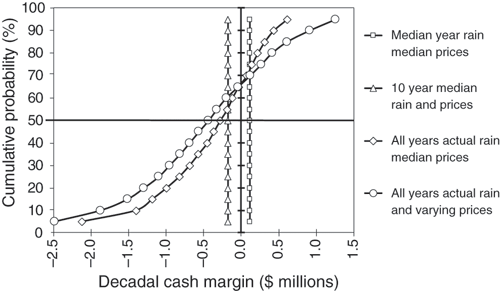
|
The defining measure of farm financial risk, as produced by the IF model (Hutchings et al. 2016) is the probability of any change in the long term cash balance, which is the component of farm equity under management control.
Dynamic analysis with the IF model
As mentioned earlier, we chose 10-year (decadal) budgets because that is sufficiently long to measure the long-term variability over entire rotations, and therefore simulate production and financial risk for each management option in each iteration. Each of these 50 decades that can be sampled from our 60-year (1950–2010) weather sequence can be priced differently, using the price series generated for that iteration. This produces unique combinations of prices and weather records for each of the 2000 decadal iterations for each strategic setting of sowing method and stocking rate examined. These generated price series are assigned to each commodity and each year in each randomly sampled decade. Most cells in the 10-year budget, representing each line item for each year in the variable, fixed and capital costs including accumulated interest and income tax, dynamically adjust to the variation in yield and price, according to rules set up in the model by the farmer. Each iteration therefore represents an individual and independent state of nature for that 10-year budget scenario.
Consequently, these budgets can be used in a Monte Carlo analysis (Nuthall 2011, p. 333) to calculate a probability distribution of long-term outcomes for a large number of equally possible random-combination scenarios of decades and price series. Running each sowing method–stocking rate treatment for 2000 scenario iterations gives a within-treatment variation between runs of <0.5% in median decadal cash margins. Therefore, 2000 was the number of iterations per treatment standardised for this paper.
We have used terms such as ‘annual gross margin’ and ‘decadal cash margin’. The farm’s annual gross margin is the farm’s annual gross income less the farm’s annual variable costs, but these annual variable costs account for only 30–40% of total costs. Subtracting from the annual gross margin the farm’s ‘fixed and capital costs’ (40–50% of all costs), ‘living costs’ (5–15% of all costs) and ‘tax & cumulative interest costs’ (0–25% of all costs) gives a measure of ‘annual cash flow’. The measure called ‘decadal cash margin’ is the farm’s cash balance at the end of year 10 minus the opening cash balance at the beginning of the decade. A farm is assumed to be viable if it maintains a positive median decadal cash margin. With variations in growing conditions and in prices within and among decades, considerable variations in ‘decadal cash margins’ will likely continue for any farm over time. These are plotted as probabilistic ‘risk profiles’.
We use the term ‘equity’ to express the proportion of the farm’s total assets remaining at a point in time after all farm debts are subtracted. Farm debts are commonly ≥20% of total farm assets in the study area. This is why we use examples in which opening ‘equity’ is assumed at 80% (Fig. 6); results for 60% and 100% equity are also illustrated (Fig. 7). Equity is so important because debt accumulates rapidly due to the compounding of interest.
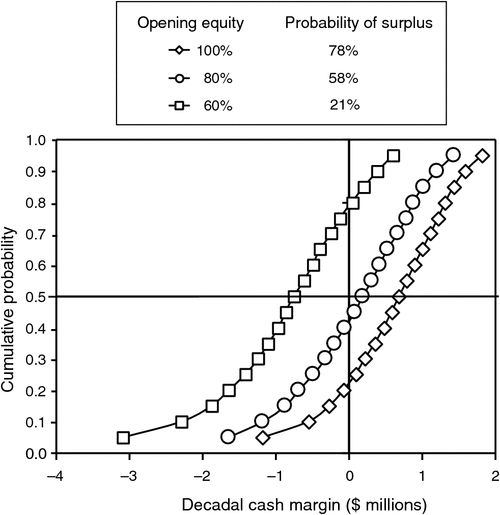
|
Pasture establishment method and stocking rates
It is clear that pasture sowing method and stocking rates influence the median outcomes for farm finances in terms of ending decadal cash margins (as the connected points in Fig. 6). In terms of median long-run cash margins for the Coolamon area, lucerne establishment by sowing alone dominated cover-cropped scenarios at stocking rates of 10, 15 and 20 DSE/ha. The low stocking rate of only 5 DSE/ha did poorly with either sowing method, offering the lowest chances of improving decadal cash margins. The peak median cash margin for pastures sown with a cover crop appears to be ~10 DSE/ha, whereas that for pastures sown alone is ~15 DSE/ha. The difference equates to an extra 2000 DSE (5 DSE/ha × 400 ha pasture), which generates sufficient additional income to deliver positive differences in median decadal cash margins. This reflects, in financial terms, the effects of higher carrying capacity of the often-higher, more stable energy yields of pastures sown alone than of those sown with a cover crop (recall Fig. 3).
Figure 6, importantly, shows that both pasture sowing method and stocking rate influence not only the median outcomes for farm finances, but also the ranges of likely outcomes. The vertical bars span the 10 percentile lower to 90 percentile upper ranges of variations in decadal cash margins. In the cases of the two 5 DSE/ha treatments, there is little difference due to sowing method in their poor prospects for positive decadal cash margins. This low stocking rate does not generate sufficient income to meet the farm costs. At the higher stocking rates, not only do the ranges largely overlap, but they also reveal different degrees in risks of loss and gain. For example, consider the declining lower tails in the 10, 15 and 20 DSE/ha sequence of stocking rates for pastures sown with a cover crop, whereas the upper ends of the 10 and 20 DSE/ha distributions reach similar 90 percentile decadal cash margins, ~$600 000. This illustrates a case, for pasture sown with a cover crop, where the 10 DSE/ha system has a higher median cash margin and is more stable than that with 20 DSE/ha (Fig. 6b). Similar comparisons are invited for the case of lucerne sown alone (Fig. 6a), where the 10 DSE/ha rate again is less risky than 20 DSE/ha. For both sowing methods, the highest stocking rates have high dependence on costly supplementary feed (recall Fig. 4), which contributes to their lower median cash margins and higher variances than seen with mid-range stocking rates.
The arrow in Fig. 6a points to the simulated distribution of decadal cash margins for pasture sown alone and stocked at 15 DSE/ha. This corresponds to the cumulative distribution function for the 80% opening equity level in Fig. 7.
Equity levels have a major influence on farm financial outcomes (Fig. 7). Pastures sown alone and stocked at 15 DSE/ha showed the highest positive median probability of improved long-run cash margins (Fig. 6a), assuming 80% opening equity. When expressed in probabilistic terms, the vertical range of variations in Fig. 6 becomes the horizontal range in Fig. 7. Likewise, at the 80% opening equity level, a positive median decadal cash margin and 58% chance of surplus and long-term gains is indicated in Fig. 7. At 100% opening equity, however, the same 15 DSE/ha treatment indicates a 78% chance of surplus and of improving long-run cash margins further. In sharp contrast is the case of 60% opening equity, where the same treatment shows a 79% chance of loss and further reduced long-run cash margins.
Conclusions
Our results indicate a more probable financial advantage to the farm business from sowing rainfed lucerne pasture alone without a cover crop, if the farm is not deeply in debt. Given this caveat, we cannot reject the recommendations from agronomy experiments run over many decades in the region in favour of direct sowing. The conundrum remains of why sowing of lucerne with cover crops continues to be such a popular technique among farmers in the study area. We cannot suggest that either approach to establishing lucerne will lead to substantially better financial outcomes for a farm that is deeply in debt. Also, at low stocking rates (i.e. 5 DSE/ha), there is no financial advantage in either establishment approach.
The specific results found here for Coolamon conditions cannot be expected to hold where conditions are very different with respect to weather, production systems or costs. Areas less prone to drought events may find more frequent success in lucerne sown with crops. Such an hypothesis could be subjected to similar tests for financial stability.
Advice to farmers based on average years, average prices and gross margins can be very misleading in any case. These common measures mask the wide range of likely whole-farm outcomes due to price and yield variations and the effects of debt on farm business viability. Chasing higher production alone can drive farmers into unsustainable debt. In the study area, where equity in farm business is typically low and technical productivity in the field is typically good, it may often be more important for farmers to find ways of reducing costs than increasing production, because cost reduction has positive effects on cash surpluses in all years.
Conflicts of interest
The authors declare no conflicts of interest.
Acknowledgements
An earlier version (Nordblom et al. 2016) was an un-refereed conference paper. The present paper benefits importantly from critical comments by three anonymous reviewers for the journal. We acknowledge these have resulted in clarified text and graphics, improved interpretation of the findings and enriched referencing. Financial support from the GRDC EverCrop project is gratefully acknowledged. Assumptions, observations and interpretations in this study represent neither the policies of NSW DPI nor other agency or institution. The authors are responsible for any remaining errors.
References
Armstrong DP, Tarrant KA, Ho CKM, Malcolm LR, Wales WJ (2010) Evaluating development options for a rain-fed dairy farm in Gippsland. Animal Production Science 50, 363–370.| Evaluating development options for a rain-fed dairy farm in Gippsland.Crossref | GoogleScholarGoogle Scholar |
AWI (2011) Lifetimewool: more lambs, better wool, healthy ewes. Australian Wool Innovation, Sheep CRC. Available at: www.lifetimewool.com.au/Tools/NSWfeedtable.aspx
Behrendt K, Cacho O, Scott JM, Jones R (2006) Methodology for assessing optimal rates of pasture improvement in the high rainfall temperate pasture zone. Australian Journal of Experimental Agriculture 46, 845–849.
| Methodology for assessing optimal rates of pasture improvement in the high rainfall temperate pasture zone.Crossref | GoogleScholarGoogle Scholar |
Behrendt K, Cacho O, Scott JM, Jones R (2013) Optimising pasture and grazing management decisions on the Cicerone Project farmlets over variable time horizons. Animal Production Science 53, 796–805.
| Optimising pasture and grazing management decisions on the Cicerone Project farmlets over variable time horizons.Crossref | GoogleScholarGoogle Scholar |
Cregan PD (1985) Managing the seedling for establishment. In ‘Pasture renovation. Proceedings Grasslands Society of Victoria 26th Annual Conference’. Melbourne, Vic. pp. 41–46. (Grasslands Society of Victoria)
Dear BS (1989) Establishment of subterranean clover under direct drilled cereal crops. In ‘Agronomy in a Mediterranean Environment. Proceedings 5th Australian Agronomy Conference’. Perth, W. Aust. (Australian Society of Agronomy) Available at: www.regional.org.au/au/asa/1989/contributed/pasture/p-03.htm
Donnelly JR, Freer M, Salmon L, Moore AD, Simpson RJ, Dove H, Bolger TP (2002) Evolution of the GRAZPLAN decision support tools and adoption by the grazing industry in temperate Australia. Agricultural Systems 74, 115–139.
| Evolution of the GRAZPLAN decision support tools and adoption by the grazing industry in temperate Australia.Crossref | GoogleScholarGoogle Scholar |
French RJ, Schultz JE (1984) Water-use efficiency of wheat in a Mediterranean type environment. II. Some limitations to efficiency. Australian Journal of Agricultural Research 35, 765–775.
| Water-use efficiency of wheat in a Mediterranean type environment. II. Some limitations to efficiency.Crossref | GoogleScholarGoogle Scholar |
Hardaker JB, Lien G, Anderson JR, Huirne RBM (2015) ‘Coping with risk in agriculture.’ Applied Decision Analysis. 3rd edn (CABI: Wallingford, UK)
Hutchings TR (2013) Managing financial risk on dryland farms in SE Australia. PhD Thesis, Charles Sturt University, Wagga Wagga, NSW, Australia. Available at: http://purl.umn.edu/204434
Hutchings TR, Nordblom T, Hayes R, Li GD (2014) Financial risk modelling with long-run weather and price variations: Effects of pasture options on the financial performance of a representative dryland farm at Coolamon, NSW, comparing results of average-year linear programming and sequential multivariate analysis (SMA). Future Farm Industries CRC Technical Report No. 14—Economic analysis. Available at: http://ssrn.com/abstract=2495186
Hutchings T, Nordblom T, Hayes R, Li GD, Finlayson J (2016) A framework for modelling financial risk in Southern Australia: the intensive farming (IF) model. In ‘60th Annual Conference of the Australian Agricultural & Resource Economics Society’. (Contributed paper) 2–5 February 2016. Canberra, ACT. Available at: http://purl.umn.edu/235333
Li GD, Hayes RC, McCormick JI, Gardner MJ, Sandral GA, Dear BS (2014) Time of sowing and the presence of a cover-crop determine the productivity and persistence of perennial pastures in mixed farming systems. Crop & Pasture Science 65, 988–1001.
| Time of sowing and the presence of a cover-crop determine the productivity and persistence of perennial pastures in mixed farming systems.Crossref | GoogleScholarGoogle Scholar |
Lien G, Hardaker JB, van Asseldonk MAPM, Richardson JW (2011) Risk programming analysis with imperfect information. Annals of Operations Research 190, 311–323.
| Risk programming analysis with imperfect information.Crossref | GoogleScholarGoogle Scholar |
Llewellyn RS, Robertson MJ, Hayes RC, Ferris D, Descheemaeker K, Revell C (2014) Developing the role of perennial forages for crop–livestock farms: a strategic multi-disciplinary approach. Crop & Pasture Science 65, 945–955.
| Developing the role of perennial forages for crop–livestock farms: a strategic multi-disciplinary approach.Crossref | GoogleScholarGoogle Scholar |
Malcolm LR, Makeham JP, Wright V (2005) ‘The farming game, agricultural management and marketing.’ 2nd edn (Cambridge University Press: Melbourne)
McCormick J, Li G, Hayes R, Casburn G, Gardner M, Sandral G, Peoples M, Swan T (2012a) A survey of farmer practice on the establishment, duration and production of pastures in the mixed farming zone of southern New South Wales. In ‘Capturing opportunities and overcoming obstacles in Australian agronomy. Proceedings 16th Australian Agronomy Conference’. 14–18 October 2012. Armidale, NSW. (Ed. I Yunusa) (Australian Society of Agronomy) Available at: www.regional.org.au/au/asa/2012/pastures/8077_mccormickji.htm
McCormick J, Hayes R, Li G, Nordblom T, Casburn G, Hutchings T, Moore AD, Zurcher E, Peoples M, Swan T (2012b) To under-sow or not? A decision support tool to determine the most profitable method of pasture establishment. In ‘Capturing opportunities and overcoming obstacles in Australian agronomy. Proceedings 16th Australian Agronomy Conference’. 14–18 October 2012. Armidale, NSW. (Ed. I Yunusa) (Australian Society of Agronomy) Available at: www.regional.org.au/au/asa/2012/pastures/8079_mccormickji.htm
McCormick JI, Hayes RC, Li GD, Norton MR (2014) A review of pasture establishment by under-sowing with special reference to the mixed farming zone of south-eastern Australia. Crop & Pasture Science 65, 956–972.
| A review of pasture establishment by under-sowing with special reference to the mixed farming zone of south-eastern Australia.Crossref | GoogleScholarGoogle Scholar |
McDonald W, Orchard P (2017) Using DSEs and carrying capacities to compare sheep enterprises. NSW Department of Primary Industries. Available at: www.dpi.nsw.gov.au/agriculture/budgets/livestock/sheep-gross-margins-october-2015/background/dse
Moodie AWS (1936) Sowing lucerne with wheat. Light seedings for grazing stands in restricted rainfall areas. The Agricultural Gazette of New South Wales 47, 419–423.
Moore AD (2014) The case for and against perennial forages in the Australian sheep–wheat zone: modelling livestock production, business risk and environmental interactions. Animal Production Science 54, 2029–2041.
| The case for and against perennial forages in the Australian sheep–wheat zone: modelling livestock production, business risk and environmental interactions.Crossref | GoogleScholarGoogle Scholar |
Nordblom TL, Hutchings TR, Hayes RC, Li GD (2015) A framework for modelling whole-farm financial risk. In ‘59th AARES Annual Conference’. (Selected paper) Rotorua, New Zealand, 10–13 February 2015. Available at: http://purl.umn.edu/202581
Nordblom TL, Hutchings TR, Li GD, Hayes RC, Finlayson JD (2016) Financial risk analysis of lucerne pasture establishment: under-sowing vs direct sowing. In ‘60th AARES Annual Conference’. (Contributed paper) Canberra, ACT, 2–5 February 2016. Available at: http://purl.umn.edu/235420
Nuthall PL (2011) ‘Farm business management: analysis of farming systems.’ (CAB International: Wallingford, UK)
Oliver YM, Robertson MJ, Stone PJ, Whitbread A (2009) Improving estimates of water-limited yield of wheat by accounting for soil type and within-season rainfall. Crop & Pasture Science 60, 1137–1146.
| Improving estimates of water-limited yield of wheat by accounting for soil type and within-season rainfall.Crossref | GoogleScholarGoogle Scholar |
Rodriguez D, deVoil P, Power B, Cox H, Crimp S, Meinke H (2011) The intrinsic plasticity of farm businesses and their resilience to change. An Australian example. Field Crops Research 124, 157–170.
| The intrinsic plasticity of farm businesses and their resilience to change. An Australian example.Crossref | GoogleScholarGoogle Scholar |
Scott JF, Lodge GM, McCormick LH (2000) Economics of increasing the persistence of sown pastures: costs, stocking rate and cash flow. Australian Journal of Experimental Agriculture 40, 313–323.
| Economics of increasing the persistence of sown pastures: costs, stocking rate and cash flow.Crossref | GoogleScholarGoogle Scholar |
Scott JF, Cacho OJ, Scott JM (2013) Economic risk analysis of different livestock management systems. Animal Production Science 53, 788–795.
| Economic risk analysis of different livestock management systems.Crossref | GoogleScholarGoogle Scholar |
Sinnett A, Ho CKM, Malcolm B (2017) Expanding a dairy business affects business and financial risk. Animal Production Science 57, 2167–2174.
| Expanding a dairy business affects business and financial risk.Crossref | GoogleScholarGoogle Scholar |
Smith JAC, Argyle DB (1964) Establishing wheatbelt pastures—don’t use a cover-crop. Journal of Agriculture Western Australia 5, 134–140.
Swan AD, Peoples MB, Hayes RC, Li GD, Casburn GR, McCormick JI, Dear BS (2014) Farmer experience with perennial pastures in the mixed farming areas of southern New South Wales: on-farm participatory research investigating pasture establishment with cover-cropping. Crop & Pasture Science 65, 973–987.
| Farmer experience with perennial pastures in the mixed farming areas of southern New South Wales: on-farm participatory research investigating pasture establishment with cover-cropping.Crossref | GoogleScholarGoogle Scholar |
Trapnell L, Malcolm B (2014) Expected benefits on and off farm from including lucerne (Medicago sativa) in crop rotations on the Broken Plains of north-eastern Victoria. Australian Farm Business Management (AFBM) Journal 11, 19–40.


